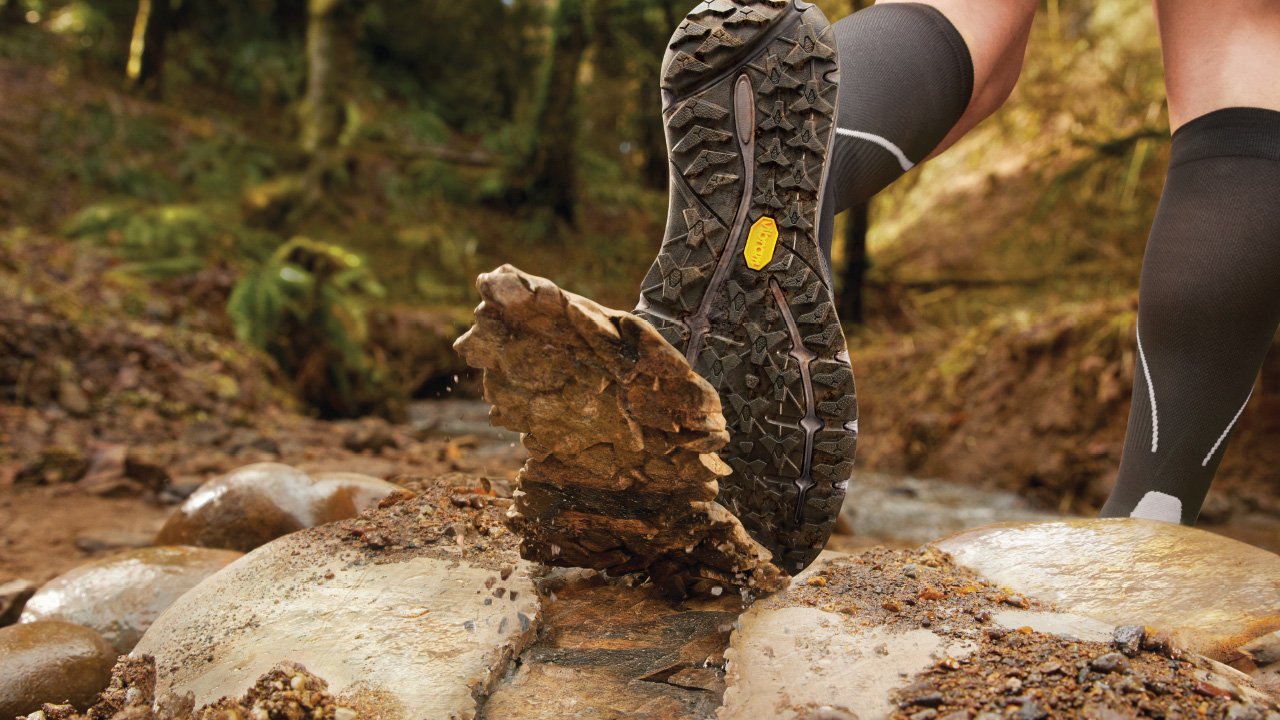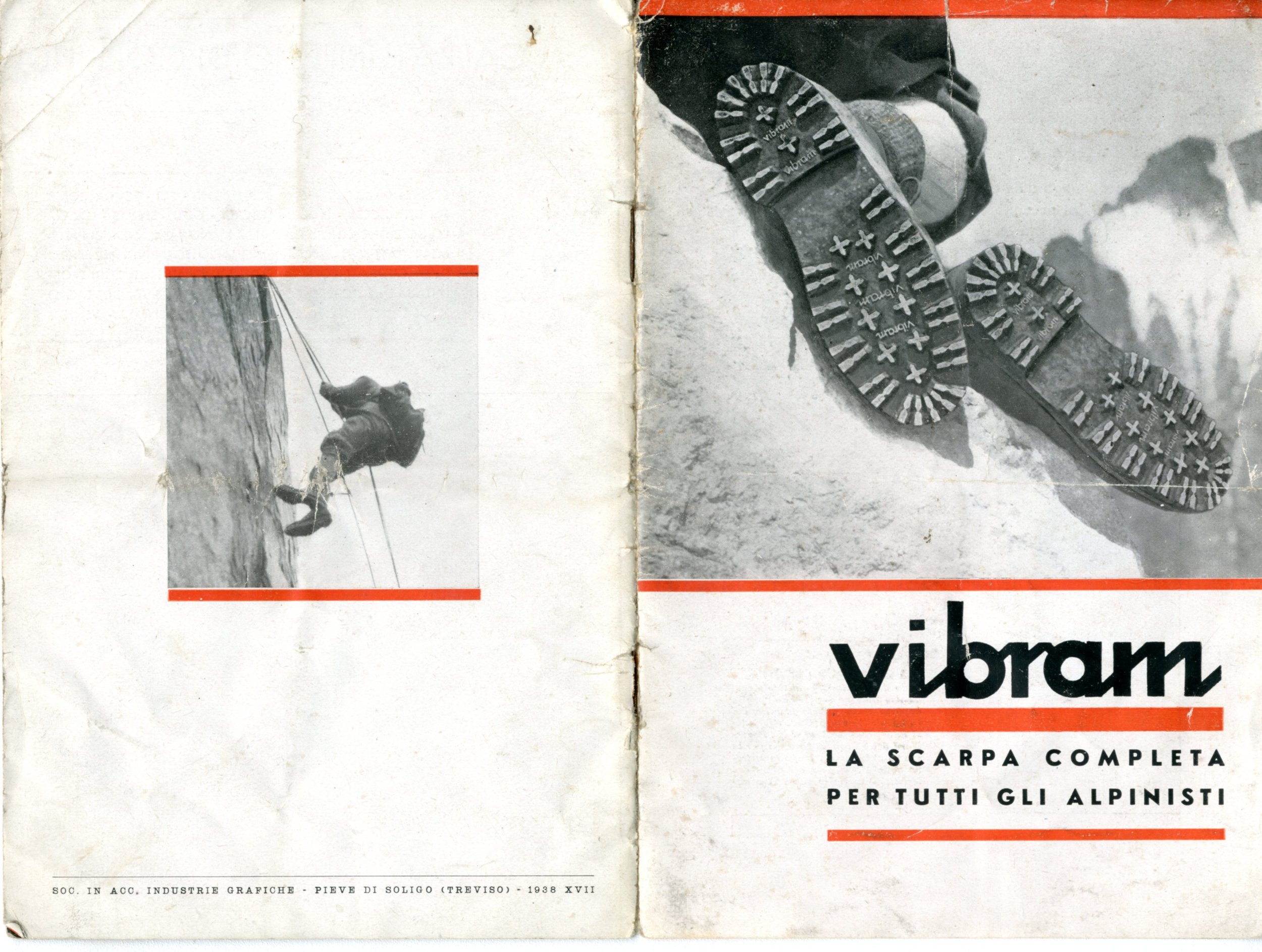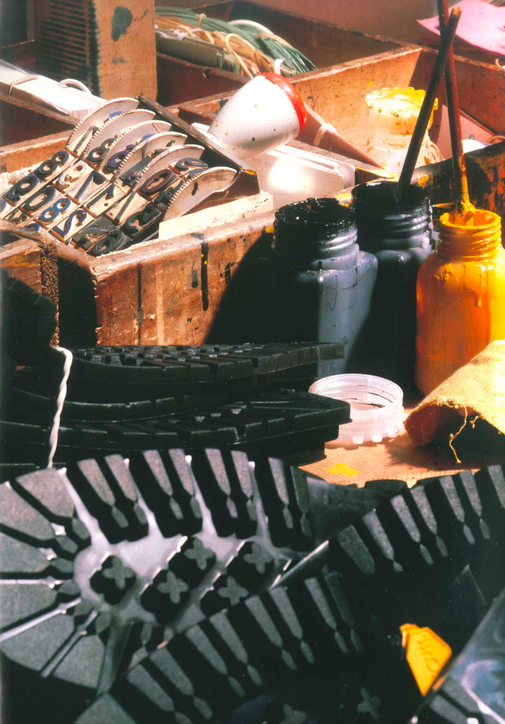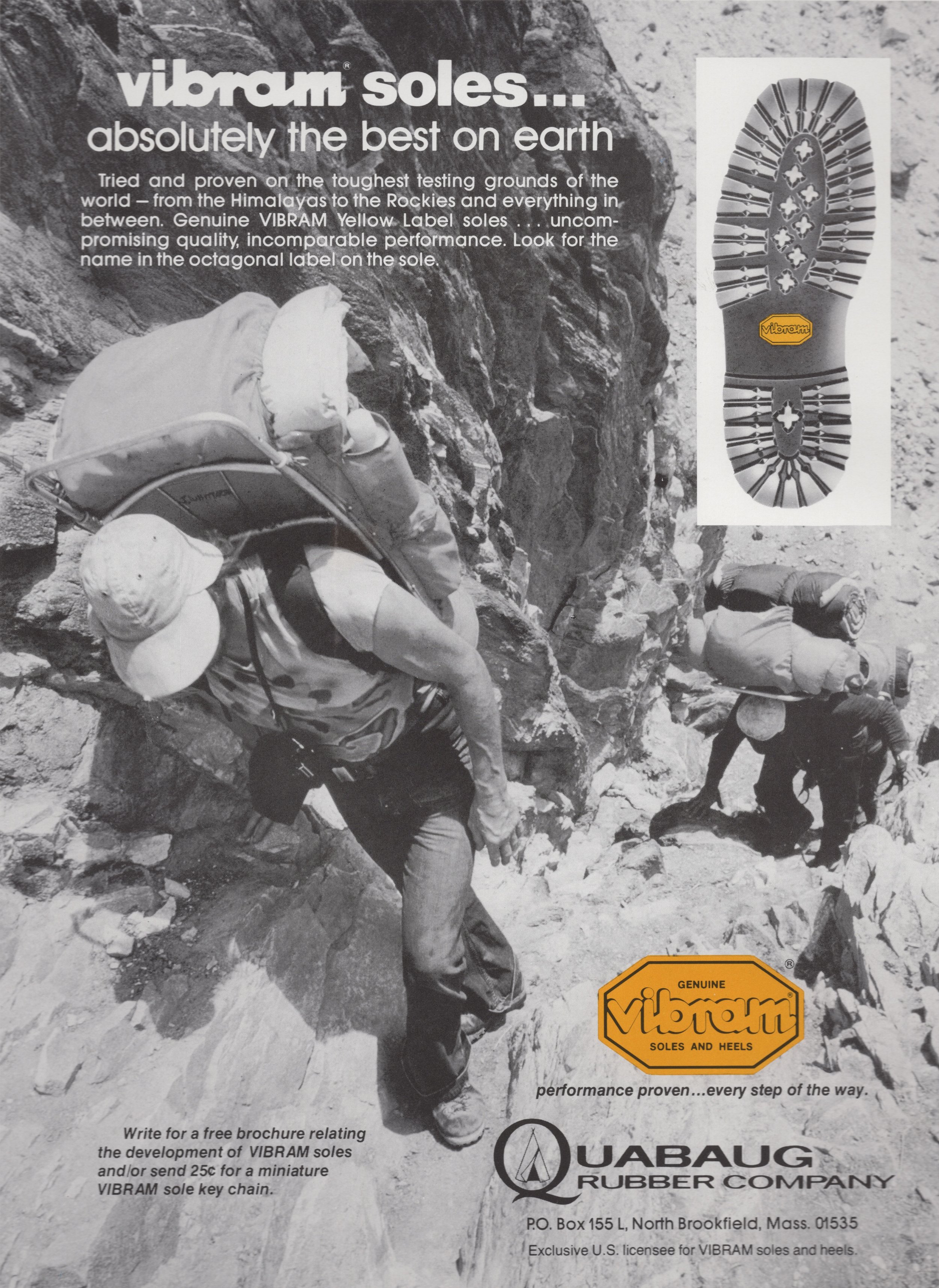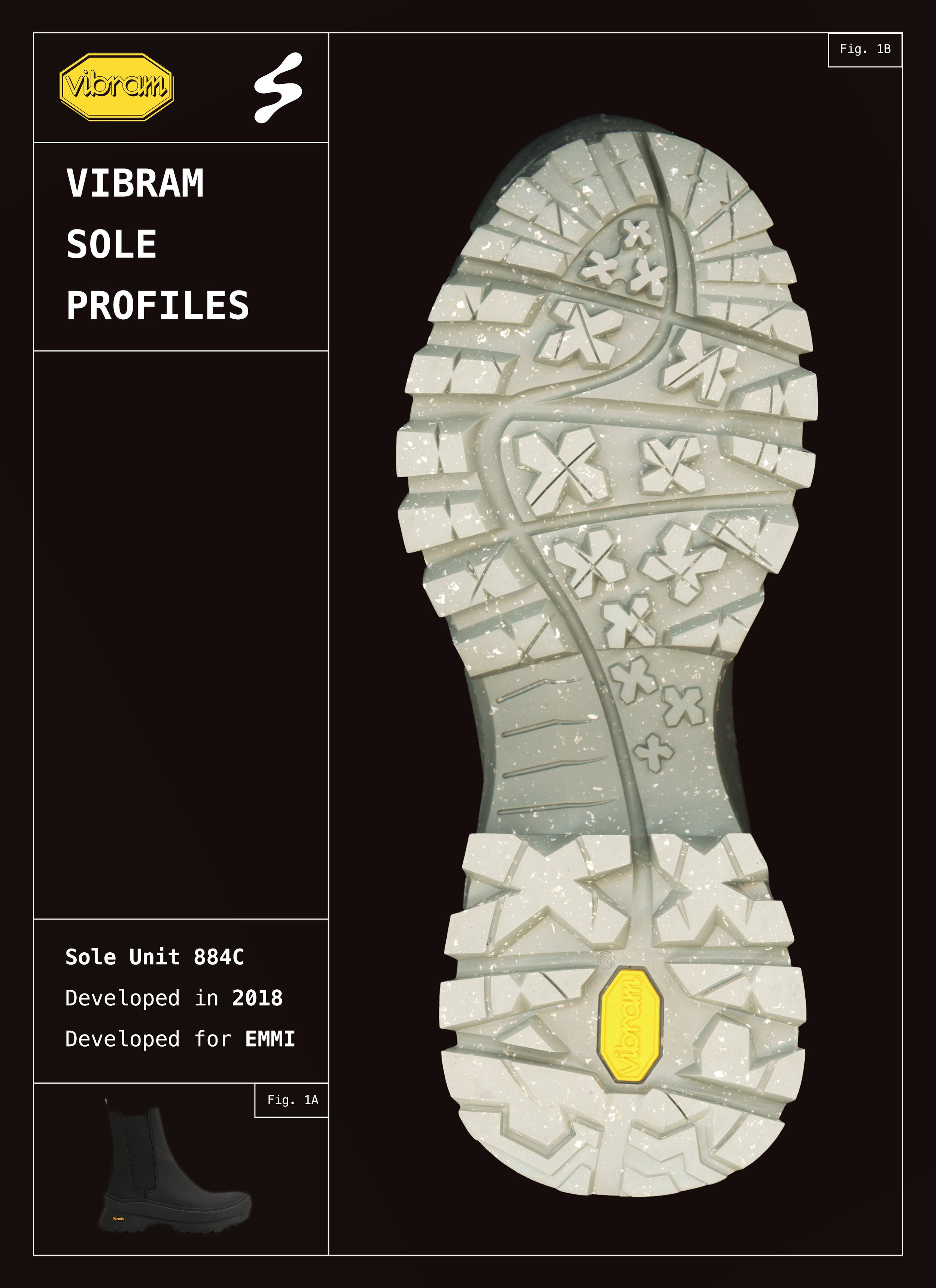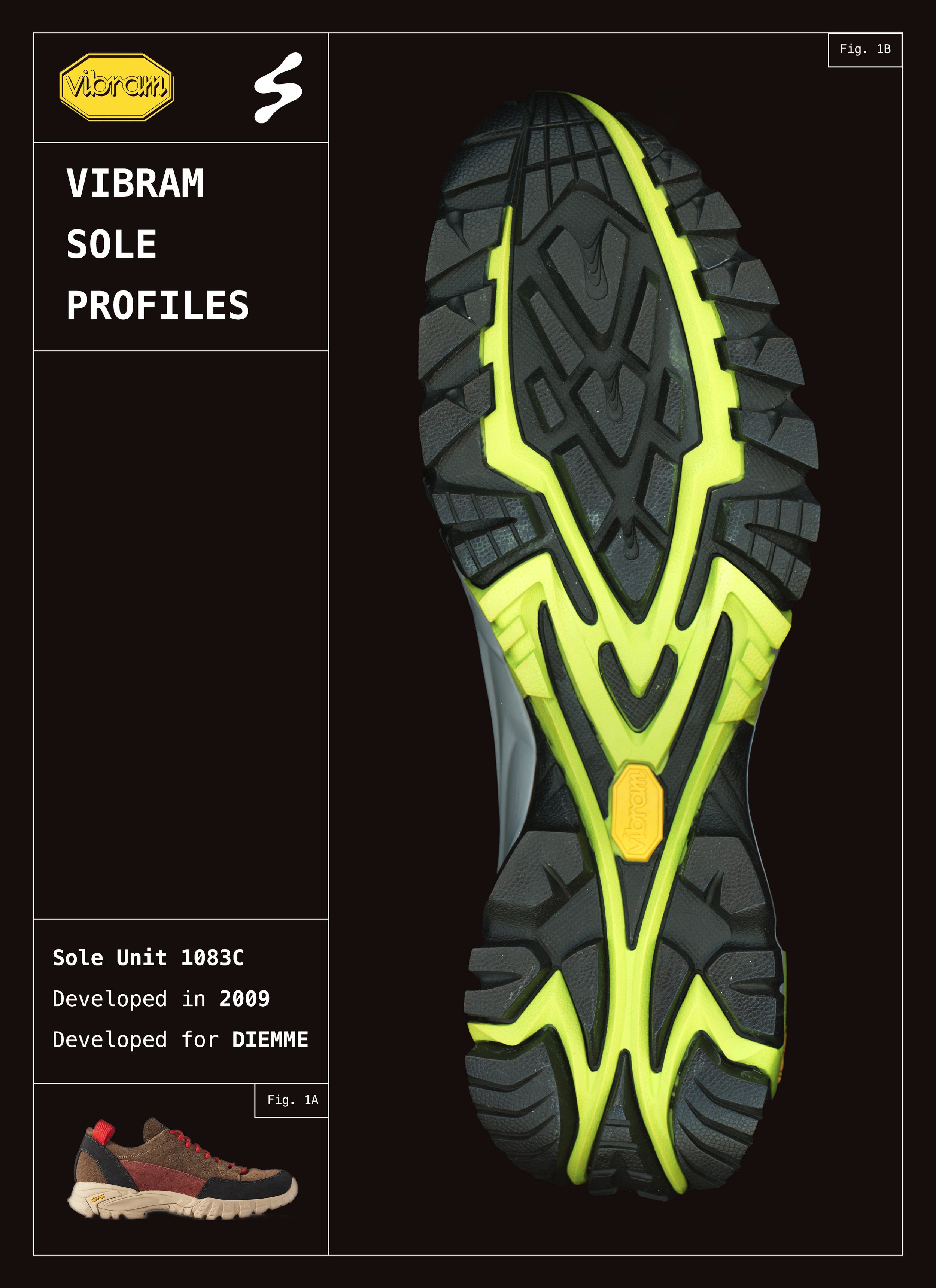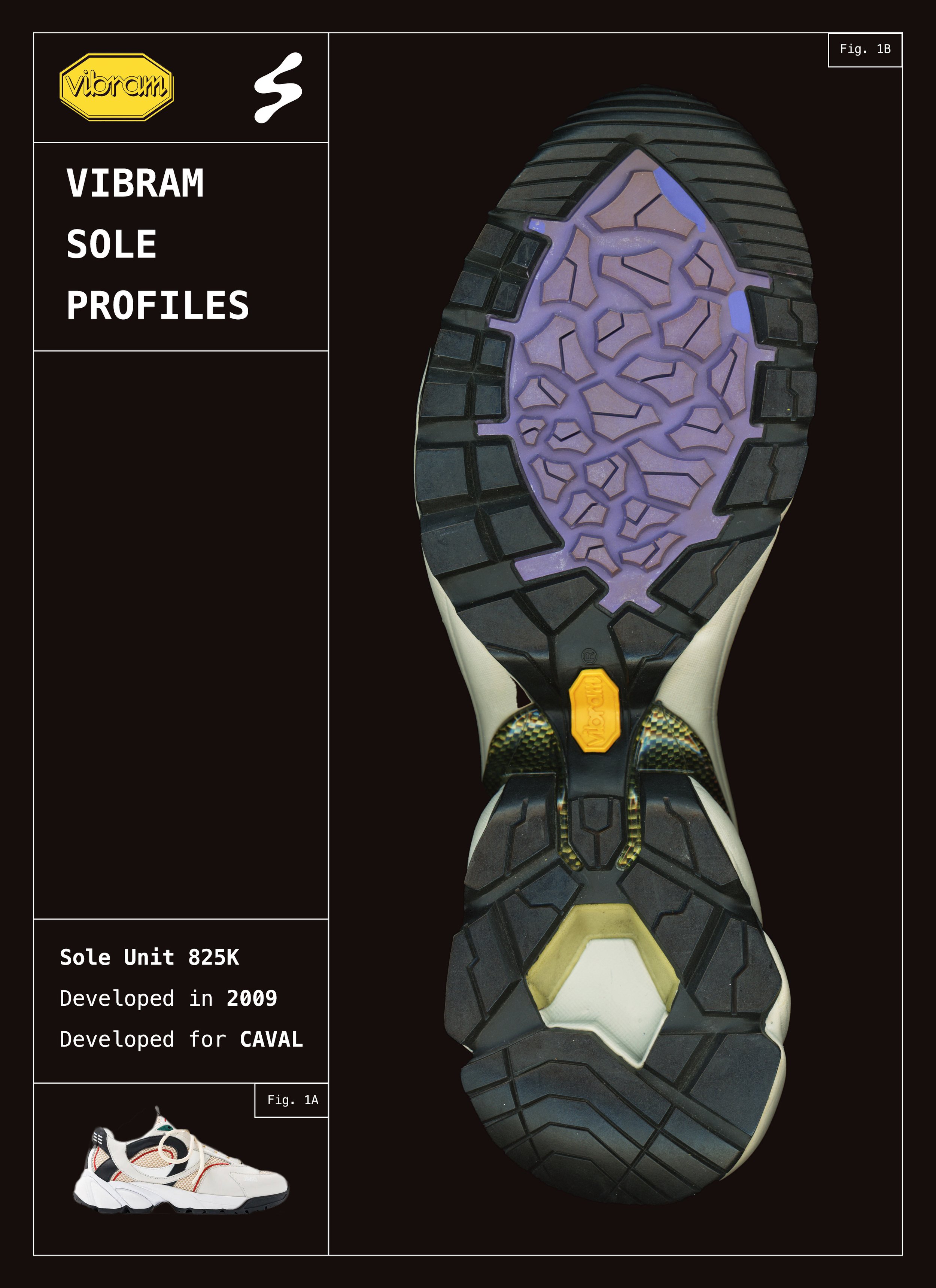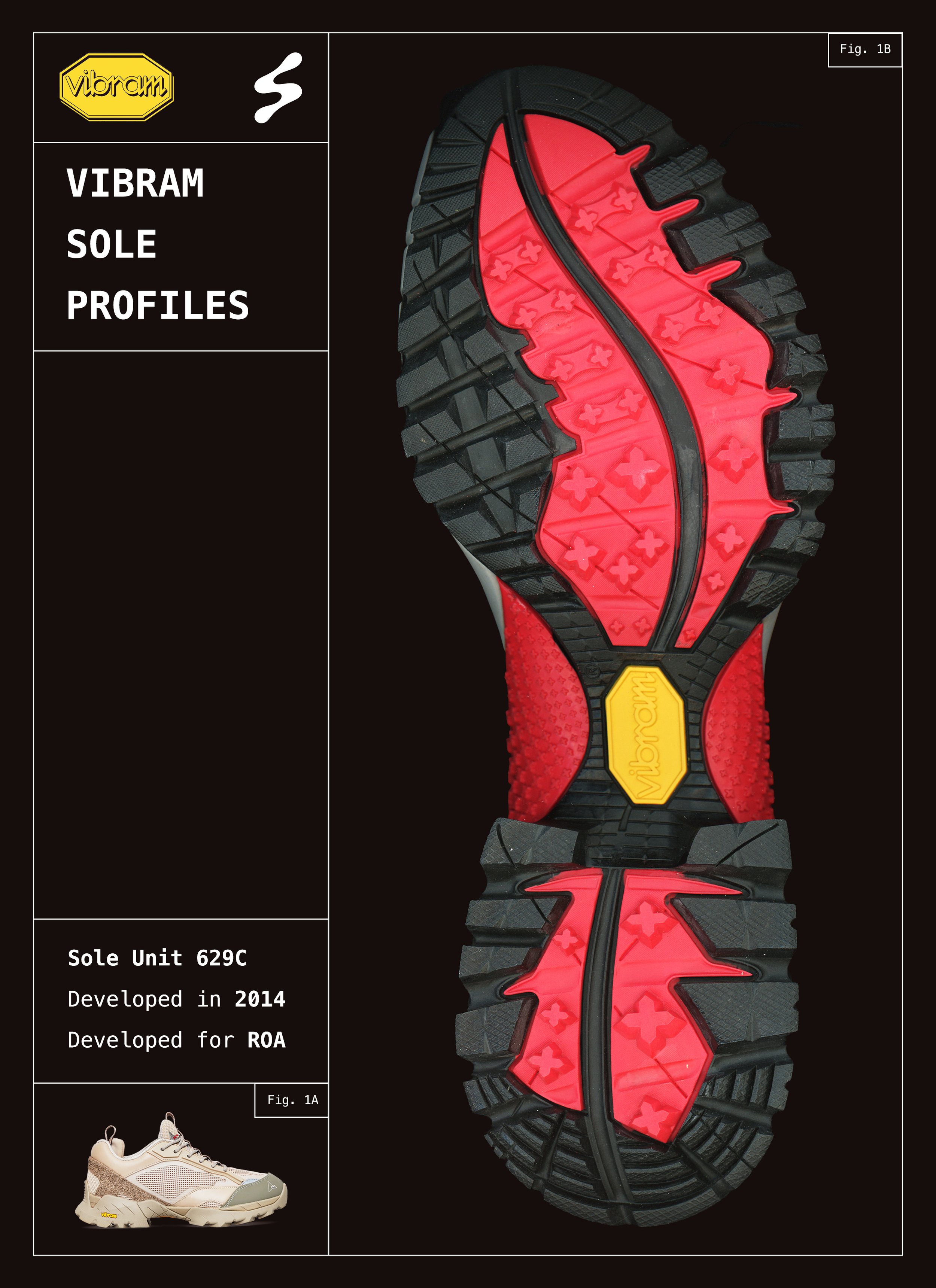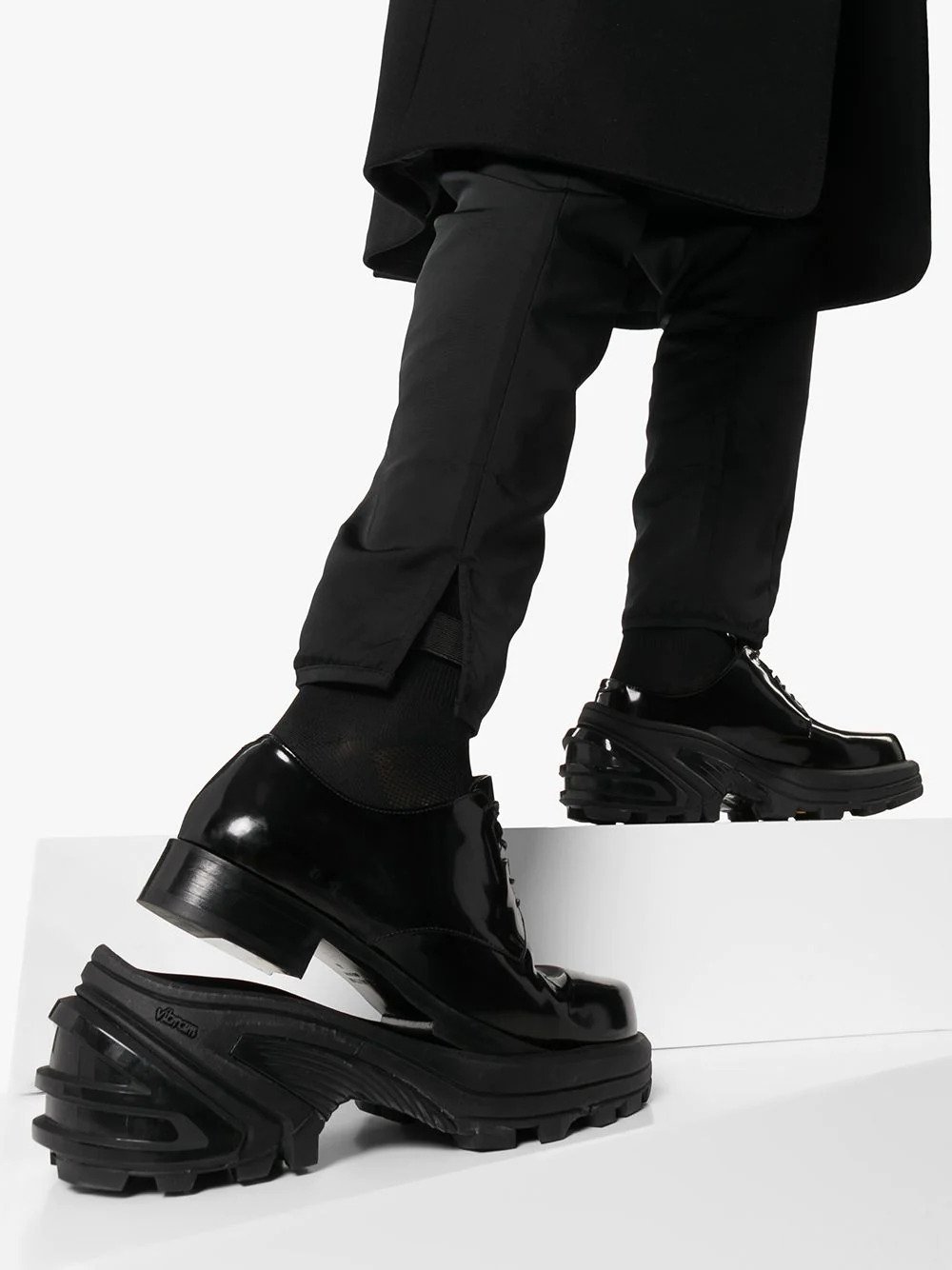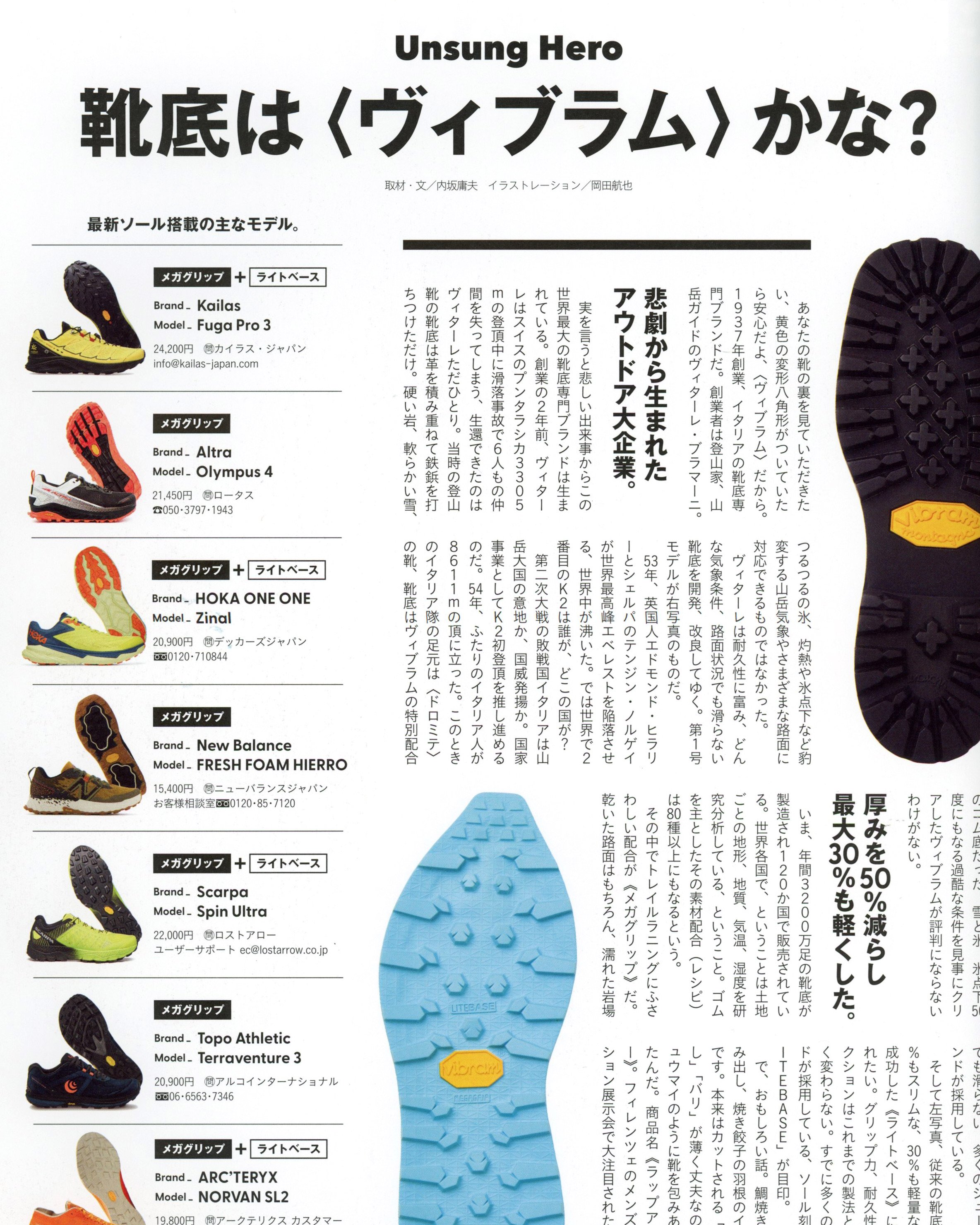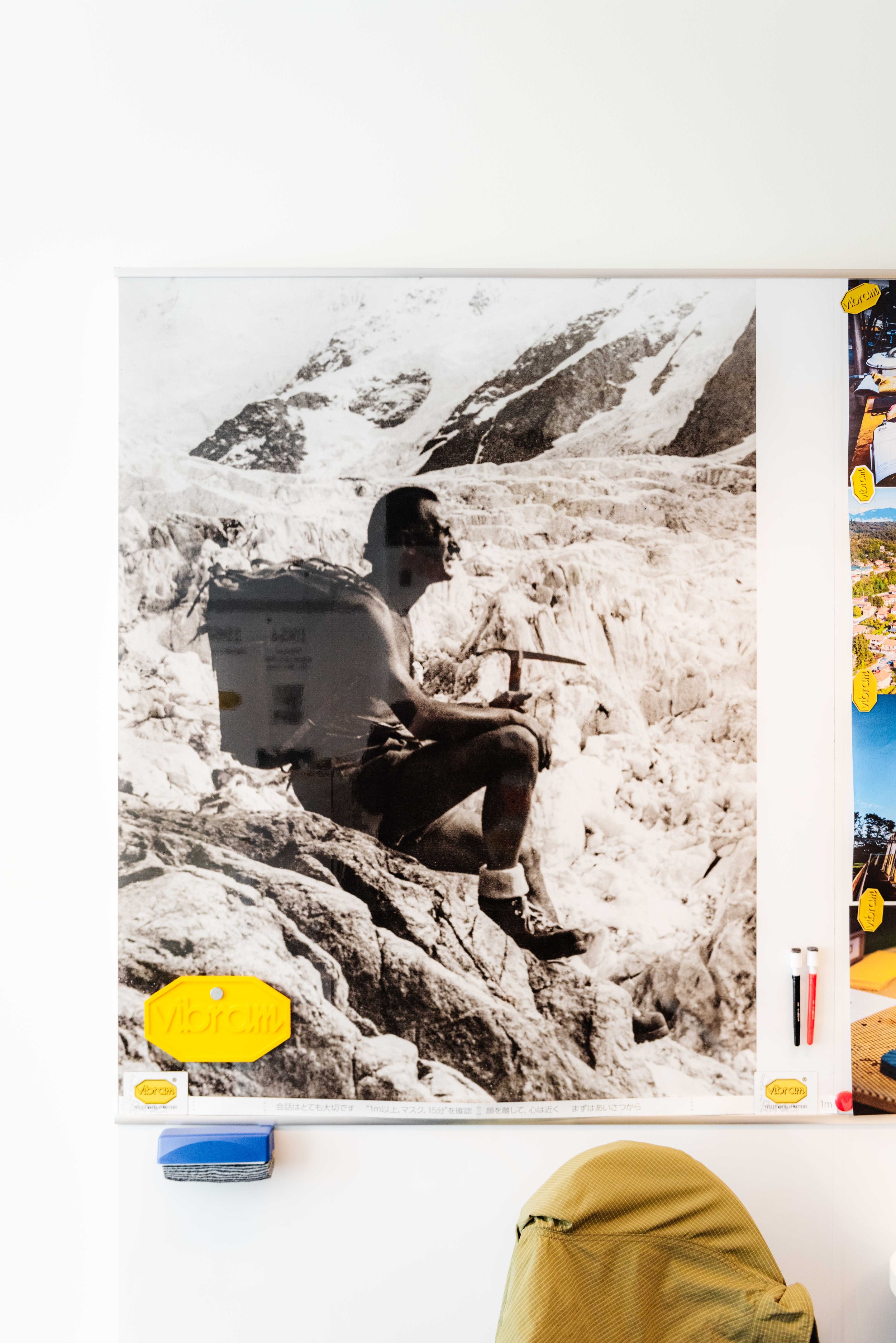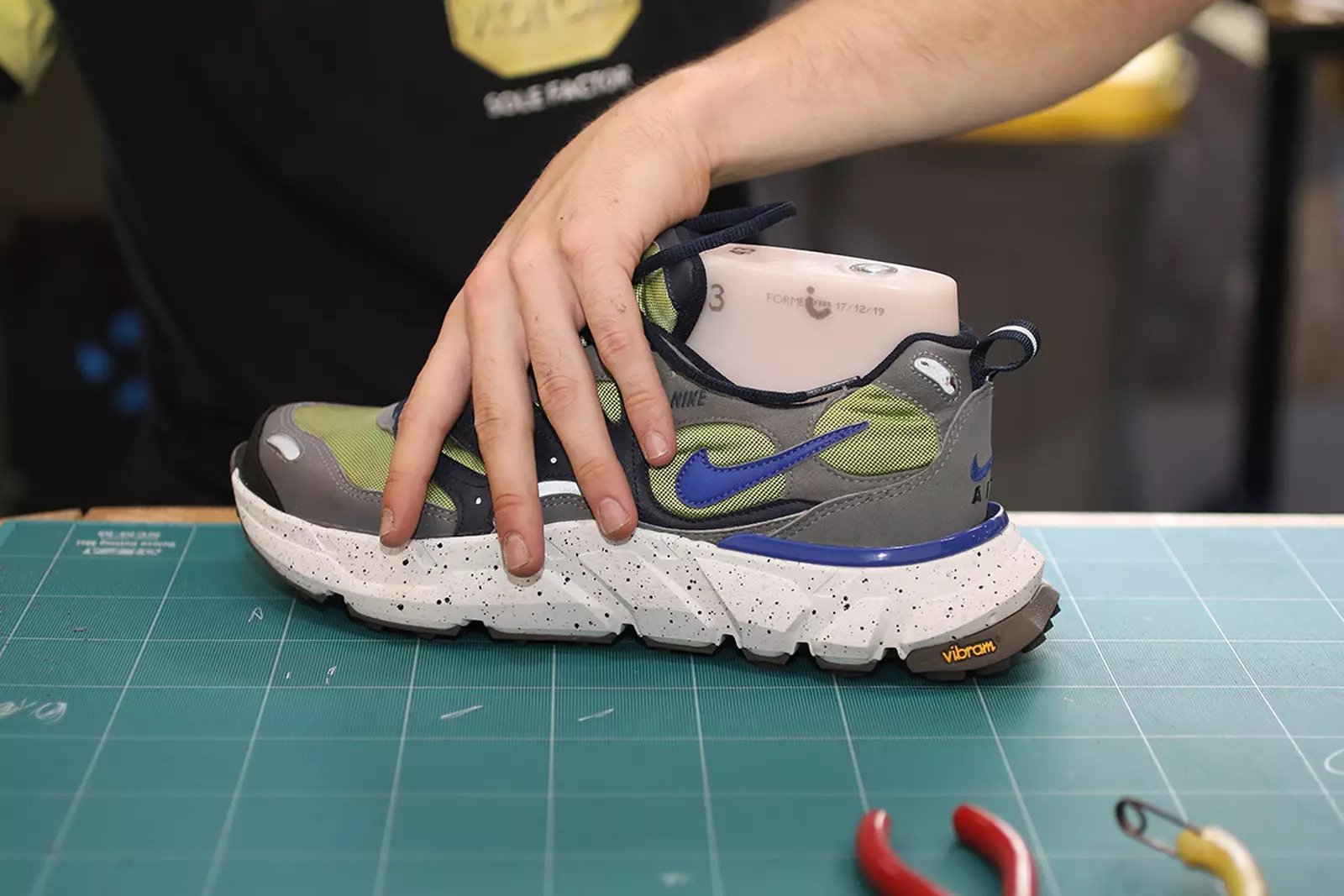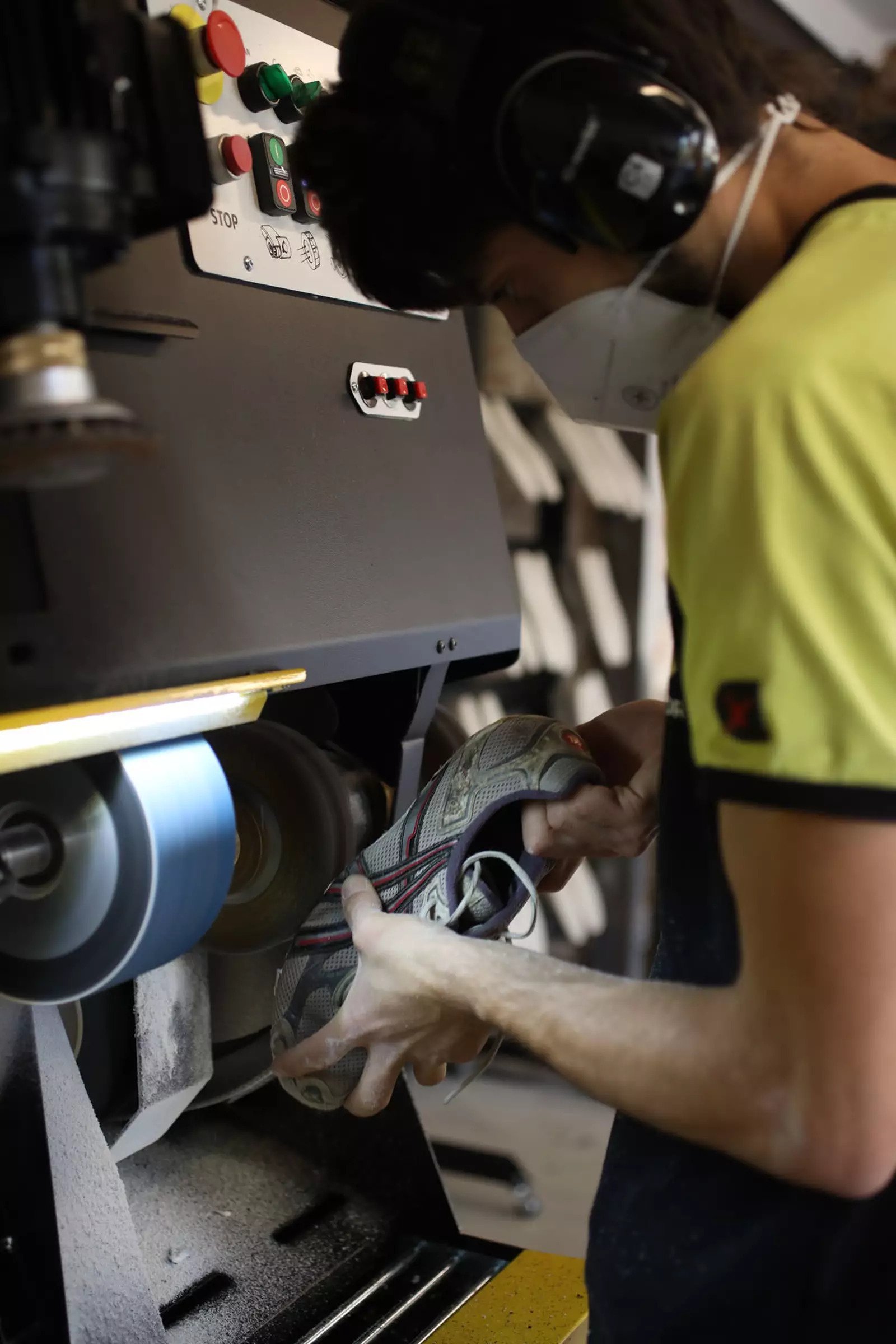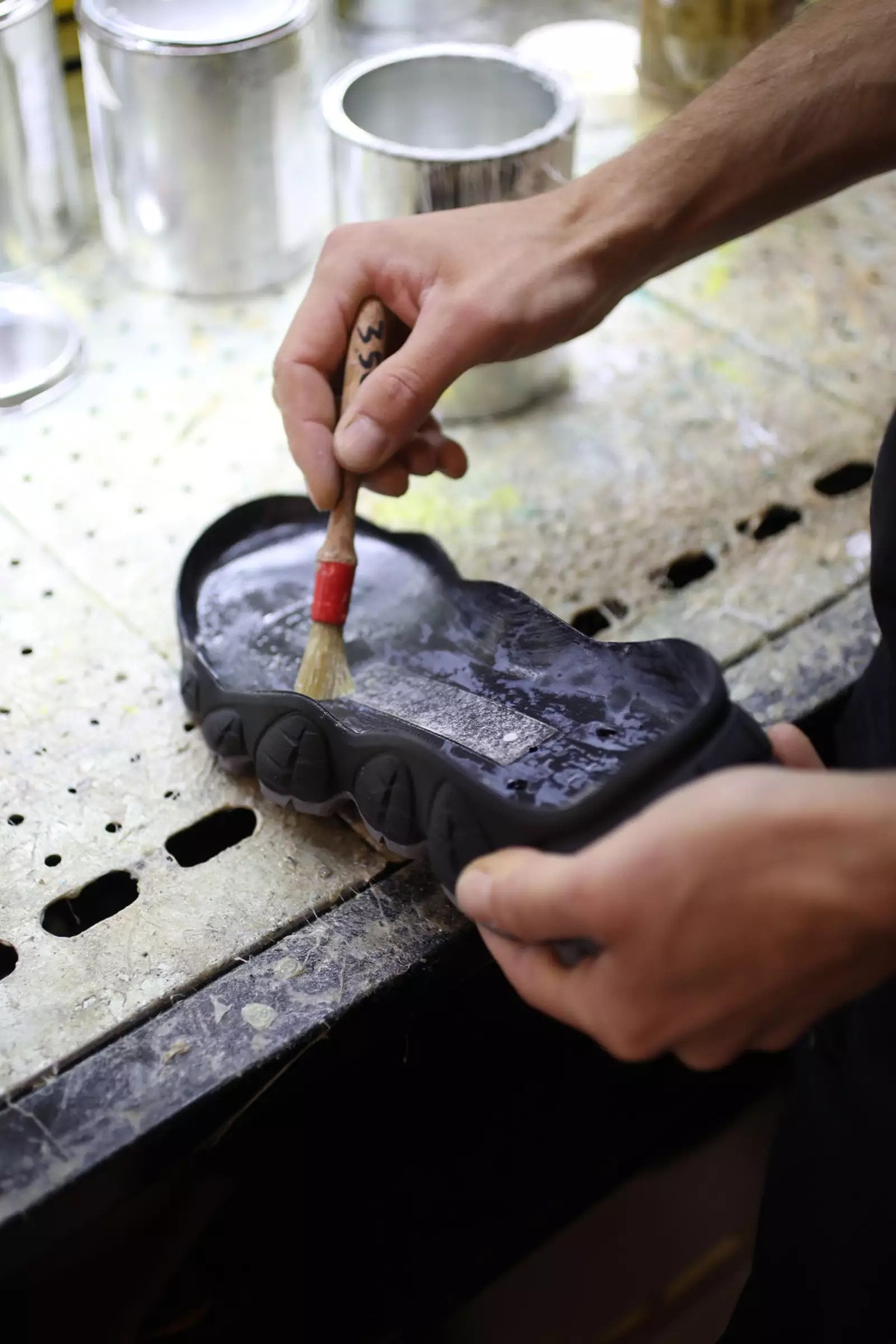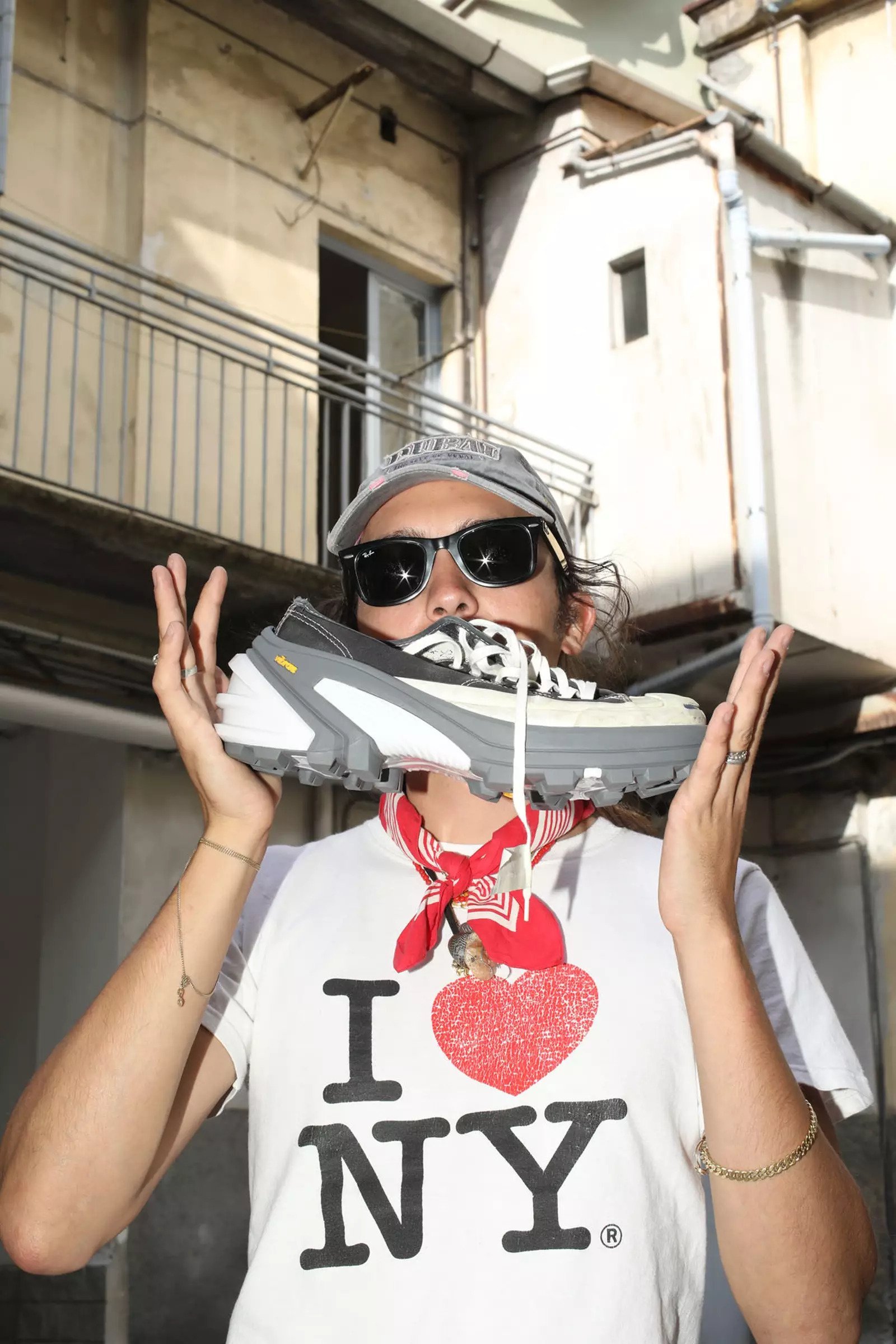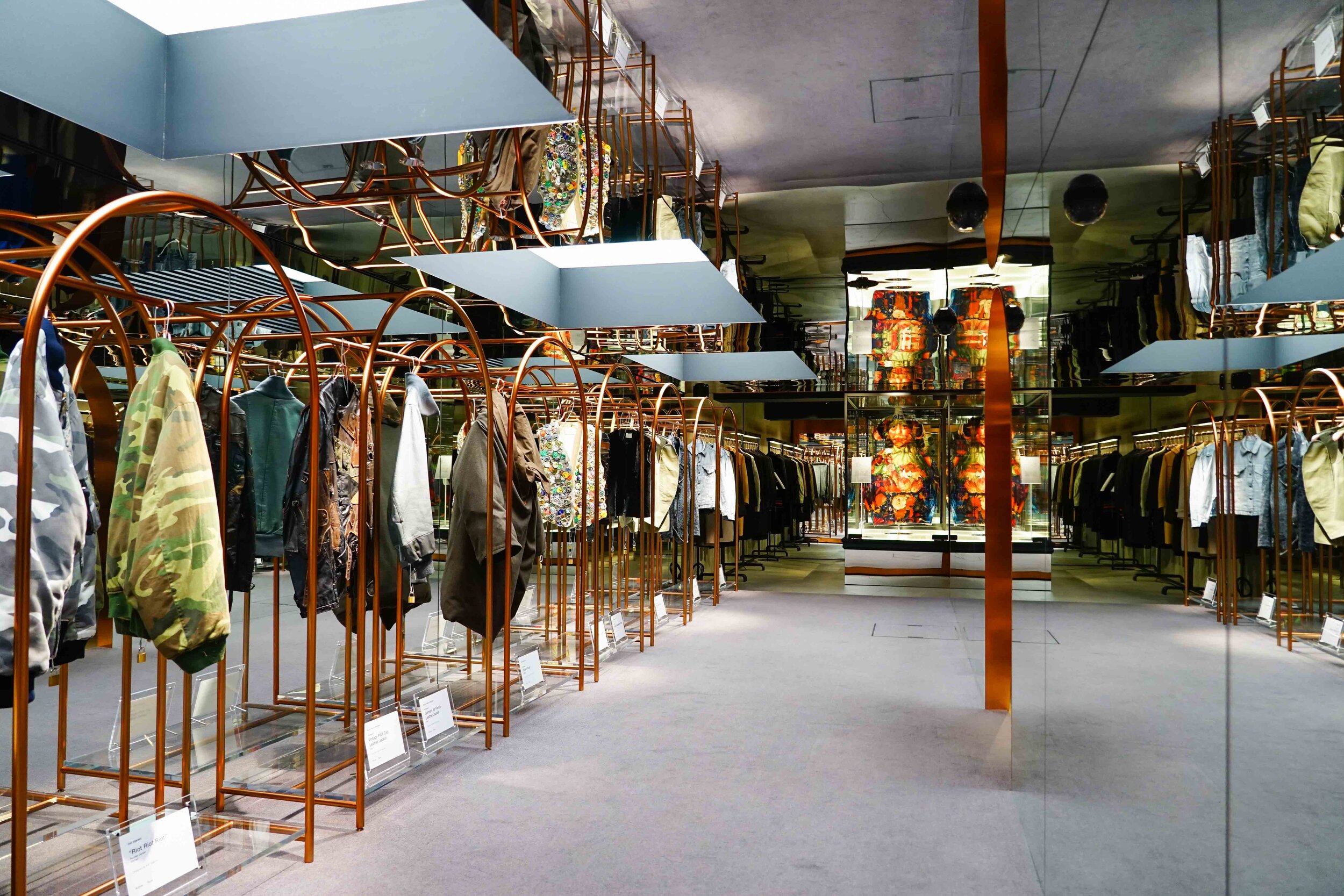Vibram - Forever stepping into the future

The world is a forever-changing place. Lifestyles change, cultures change, and trends change. Things come and go, and what is today’s headline becomes yesterday’s news faster than ever. There is one industry this is apparent in even more than most, and that is the cyclone that is the fashion industry.
From the Alps to Runways
The fashion industry is known to be a constant progressive climb of bettering ourselves. An uphill battle of getting the next best thing, but this particular uphill climb has no peak; it’s the mountain that can never be conquered because every step forward we take lights up a new trail for us to explore. This is the beauty and the curse of the fashion industry. An ever-evolving expedition that has no end. So, on this never-ending journey why not equip yourself with the right gear to make your quest more smooth?
What if there is a brand that makes the soles of shoes for this particular expedition? That, maybe even without knowing, the majority of the people reading this would have stepped foot in whilst trying to conquer this metaphorical mountain, yet may not have even known it? And now the more and more they do know it, it’s becoming the very thing they are climbing for. Well, that brand exists, and its name is Vibram. A household name amongst a multitude of different cultures and scenes, but none more so than the walking, climbing, and exploring community, Vibram not only sits on top of the mountain but was the first to reach it too.
Vibram, named after its creator Vitale Bramani, is an Italian company, with global headquarters in Albizzate, one hour from Milan, Italy, that manufactures the production of Vibram branded rubber outsoles for footwear. Vibram’s focus is to create an incredibly durable, comfortable, and functional sole that can tackle even the most challenging terrain, and it’s rich history proves that when it comes to taking a step, Vibram always heads in the right direction. But to say that this is all they do would be an insult to their long legacy of innovation. From the moment Vibram released it’s first sole, the Carrarmato, which single-handedly changed the future of mountaineering, to its ongoing symbiosis with the fashion world, Vibram’s name, and the trust it provides to the consumer is the epitome of quality. But what does Vibram have to do with the aforementioned journey of fashion? Well, let’s get into that.
Vibram has been crafting soles since 1937, so it is safe to say that they have touched the heels, and lives, of millions of people. And if you don’t believe us when we say the majority of you would have stepped foot in them, then we urge you to check your collection, turn your shoe upside down, and watch out for the iconic yellow octagonal Vibram logo that marks the seal of approval for your shoes. We guarantee somewhere you’ll find a Vibram sole still looking as good as it did the day it first blessed the upper of your shoe. And it is not just for mountaineering. Brands such as Suicoke, Visvim, ROA and Our Legacy [with this list barely even scratching the surface of the roster] have all utilised Vibram’s technology and knowledge to further increase the power of their products. Few brands have managed to create such an impact as Vibram has within their industry, and they continue to do so in new and innovative ways.
To put it simply, Vibram to shoes is what Gore-Tex is to outerwear. It is not only a sign of trust to the customers that they will be getting a high-quality product, but it has transcended this and is now a household name that seamlessly goes hand in hand with fashion. They are no longer just sitting on the sidelines ensuring functionality and comfortability, they are an ingredient in fashion that the runways in Paris and the streets of Milan are lapping up more and more by the day. Functionality is now fashion, and with genres such as gorpcore, techwear, and more utilitarian styles continuing to rise in trend within the fashion scene in the last few years, it’s no wonder that one of the most functional brands to ever do it is now cementing itself as a key component.
So, why is Vibram such an incredibly dominant brand in its field? And what makes its technology sit amongst the top, with the likes of Gore-tex, Cordura, and our new favourite textile wizards, Byborre? Well, to learn more about the brand we are going to take you through the incredible history of the Vibram legacy, dive into the creation of the sole that changed the game forever, the Carramato, and interview Matteo Bramani, board member of Vibram and great Grandson to Vitale, to give you an insight into exactly why Vibram goes down in history as a paragon of both function and fashion.
The Man of the Mountains – Vitale Bramani
“Only one thought consumed my mind. I have to climb”
The words of Vitale Bramani, founder of Vibram and avid climber. Born in Milan in 1900, it would be this city where his and Vibram’s journey would begin. The brand is the embodiment of Vitale as an explorer and achiever, being extremely driven even as a child. Having climbed the balconies of homes at the age of 6, and a fourteen beginning to climb mountains, he felt a need to test his willpower and tenacity. As he grew older this notion wouldn’t fade, using the mountains as a way to not only challenge himself and his personal torments but also at the same time find an inner peace that he could only achieve at the peaks. For Vitale, the mountains and climbing are a source of inspiration, his spark, and his canvas for his creativity, and it would be on these very mountains that the story of Vibram and the famous Carrarmato sole would start.
Vitale, in addition to teaching ebony carpentry following in his father’s footsteps, would immerse himself in the climbing community from a very early age. Through his years of being within the right crowd, he would become so known that he would even act as a guide to prominent personalities such as King Albert I of Belgium, who was a mountaineer also.
In 1928, Vitale with the help of his wife Maria would open the first specialised mountain gear store in Via Della Spiga 8, Milan under the name Vibram. Vibram being a merger of his first and last name, which he would already use as a sign off in his articles for CAI and SEM magazines. The shop would quickly become a hub of enthusiasts, acting as an institute and meeting point for the likes of mountaineers such as Ettore Castiglioni, and mountain enthusiasts in Milan. Among these were Counts Alberto Bonacossa and Elvezio Bozzoli Parasacchi, keen participants of the mountain expeditions organised by Bramani. In 1933 Vitale would continue to make waves in the mountain community by being awarded the Gold Medal of Alpine Honor by Angelo Manaresi, CAI [Italian Alpine Club] president at the time.
Vitale would undergo frequent expeditions throughout the years, although in 1935 during one of them Vitale would tragically lose six comrades to frostbite, due to sudden weather changes on Punta Rasica, a mountain in Val Bregaglia, Switzerland. This would be the fuel to Vitale’s fire, and after this, he would go away to craft better equipment worthy of the mountains to ensure this wouldn’t happen again. From death came birth to an invention that is frequently known as the ‘The Greatest Soles money can buy’– The Carrarmato sole. A sole that can tackle even the toughest terrains, and the first of its kind.
The Start of a Lifelong Legacy
The Carrarmato sole is a vulcanised rubber sole. The first-ever sole in fact to ever be created for mountaineering with rubber lugs which allowed for greater flexibility, abrasion resistance, and durability, the Carrarmato sole [meaning “tank thread”] would be a revolution in the footwear market. Applying the same pneumatic grip as the tires to a 3D sole, the Carrarmato would offer uncompromising effectiveness against the rough terrain of the mountains. Throughout 1935 and 1937 Vitale would test the new innovative sole on Piz Badile, a famous Val Bregaglia mountain top between Italy and Switzerland, and finally in 1937 would patent the first official Carrarmato sole.
The innovative breakthrough that was the sole was derived from the rudimentary hobnailed boot and was tested by Vitale by using the rubber prototype during his mountain excursions. Known to be a pinnacle of design, the sole utilises Central and asymmetrical cross-shaped lugs, inspired by high mountain summit crosses and by Milanese Galleria Vittorio Emanuele II flooring decorations. Perfect for expeditions due to its traction and grip on surfaces such as rock and mud, the Carrarmato sole would offer the respect that the mountains deserved, but also paid homage to the city in which it was born. These lugs are essential to the innovation of the sole, shifting the central lugs from a symmetrical orientation to an asymmetrical position, guaranteeing traction all over the sole.
The sole also provides a large area of contact with the ground, improving stability and all-terrain grip for high mountain safety. With reinforced toes and helps to improve downhill maneuvers, the Carrarmato offers a 360-degree safety net whilst traversing the trails. As well as this, the sole offers mud-clearing channels between the lugs for a self-cleaning mechanism, further enhancing the safety on heavy grounds to ensure traction throughout. Stepping in a Carrarmato sole feels like putting on a bulletproof vest for your feet.
To make this sole even better is the lifespan of a Carrarmato sole. Due to it being made with a rubber compound, the longevity and durability of the shoe are next to none. Built to withstand the harshness of the mountains, these almost indestructible fashion statements will be around a lot longer than the latest trend that hits the Paris runways.
Tried and Tested
It’s not good enough though just to tell you the facts about why the Vibram’s Carramarto is one of, if not the greatest sole to ever step foot on the Earth. These soles have been put to the test by the toughest of conditions and helped achieve greatness. Helping the Italian Expedition to scale the K2 in Asia, the second-highest mountain on Earth, in 1954 with custom Carrarmato soles designed especially for this mission on Dolomite boots. As well as this, in 1963 American climber Jim Whittaker, with his sherpa Nawang Gombu, conquered Mount Everest’s South-East corner, becoming the first American climber on the top of the highest mountain in the world, who later also conquered the K2 utilising Vibram soles.
“Second best is not good enough on the second-highest mountain in the world. That’s why every member of our K2 team insisted on the world-famous VIBRAM soles.” – Jim Whitaker
Stepping into the Future
To list the ongoing achievements and milestones that Vibram has achieved we would need to write 10 articles. Throughout the years they have explored further into new terrains and new technology to either improve on what they have done before or better equip the wearers for various scenarios and tasks. Take the Vibram FiveFingers for example. Designed as a foot glove to mimic the feeling of walking barefoot, although still with the power of Vibram sole and safety that they provide. As a mission to feel closer to the Earth than ever before, the FiveFingers model brought to market once again a game-changing approach to walking, running, and climbing.
Another stand-out invention in the past year from Vibram comes in the form of the MMW x Nike Vibram detachable sole. A detachable unit which you place on the sole of your sure to add the Vibram power to your everyday rotation. This concept was further enhanced, and although it hadn’t seen much fashionable usage widespread when it launched, it was a viral sensation as it was just something that people had not seen before. People were placing this on the rarest of kicks and showing the world something different. Similar to this, the PPS or Vibram Portable Performance Sole. A unit enabling you to attach it to your favourite trainer to turn it into a momentary functional powerhouse.
Vibram continues to push boundaries. They bring us closer to the Earth and its terrain but also allow us to conquer it, and with developments from them such as the Arctic Grip, Ecostep, and Evaflex, it’s hard to argue that once again Vibram proves itself as a paragon of footwear.
The Seal of Trust
As mentioned before, the yellow, iconic insignia of Vibram is now a measure of reassurance of longevity, and value. Like a Made in Japan tag on a piece of clothing, the Vibram name has transcended from just a sign of quality but is now a staple in the hunt for a well-made, well-respected item. From 1947 the octagonal logo would appear on every Carrarmato sole, inspired by the Milanese Vittorio Emanuele II octagonal arcade, once again paying homage to Milan, its birthplace. Having gone through various metamorphoses through the years, finally, in 1969 the Vibram logo became it’s iconic yellow to highlight the “Marco Oro” compound and symbolise its preciousness.
Bridging the gap between function and fashion
And as if conquering the world of mountaineering was not enough, Vibram is now cemented as one of the key ingredients in the fashion world. Having partnered up with the likes of Alyx 1017 for a contemporary yet utilitarian detachable sole, and Suicoke with their god-tier-like sliders, Vibram is transcending from the alps to the runways of Paris and the streets of Tokyo. Blurring the lines between function and fashion, even more, Vibram sits as one of the pinnacle names that are helping to reimagine what fashion is all about.
As well as being a key ingredient, Vibram even actively tackles current and continuous issues related to the fashion industry: responsibility and sustainability, and conscious manufacturing. As a constant effort Vibram tries to keep its footprint both transparent and as harmless as possible. Alongside this, Vibram also actively partake in the resolving of your current shoes. Creating better, more durable, and long-lasting soles for your favourite kicks to give them new life before you decide to purchase a new pair. Their "Repair if You Care" scheme invites people to be more conscious with their purchasing, and to extend the life of their current shoes. Recently we have seen them collaborating with Linus Nutland [Nike Server’s founder] in an attempt to encourage this notion of reviving sneakers, not rebuying.
A talk with Vibram
To say that Vibram has walked many paths is an understatement. Their legacy surpasses any sole makers in history, and they continue to strive for even more greatness with no sight of stopping. This not so brief introduction to the brand was just a snippet of what really lies behind the Vibram empire, so to get an even better insight and dive deeper into what makes Vibram tick, we sat down with Matteo Bramani, 4th generation of the founding family of Vibram, to interview him 83 years after his great Grandfather's dream became a reality.
Dear Matteo! Thank you very much for taking the time to talk with us!
We usually start our interviews with a very simple question. Could you please start off by telling us a little bit about yourself? Introduce yourself, who you are, how you started and what you are doing now?
Yeah sure. I am Italian, deeply rooted in the mountains of Europe, had the opportunities to travel the world and took all of the opportunities for leisure, academically and professionally. I studied in the US, I lived and studied in China, and I have a deep connection with Asia where I work, both China and Japan, where I also come along for traveling. I have a really global mindset let’s say, but I have a very deep connection with where my roots are. These places, these mountains and nature. This is who I am. I am interested to see new things and see the world from a new point of view. I feel as if to really understand the world we need to see it from different perspectives, and this is how I have been brought up.
In Vibram, I am the international business developer which means I find new markets, and new categories - I travel around different offices. I am the 4th generation of Vibram. We are a small family. My father, who is 3rd generation, is the CEO of the company and we work closely together as a family business. To give you an example, Kumiko-san was hired by my father more than 20 years ago, lived in Italy, and moved back here to Japan 10 – 12 years ago. And over at Vibram Headquarters, our general manager has been working in the company since the year I was born. So, it's deeply rooted in connection.
This company is my life, and I have had different experiences all around, but Vibram is my life and I live through the brand and live through what the brand represents.
Vibram is such a long-standing company that is really family-focused. First established in 1937, such a heritage brand. In your own words can you please share a brief introduction into this long legacy of Vibram?
Sure, sure. The word brief worries me a little bit aha, but what can I say? Vibram started in Milan. It started with a man who was a carpenter, a woodman, and someone who liked to do things. And apart from being a woodman and carpenter by profession, he was also an alpine guide, or an alpine pro academic let’s say, at the time. He loved the mountains. The mountains brought him to develop what the brand is today. He was an alpinist and was someone who liked to push the limits of being an alpinist. He was climbing from the age of 14 and 16 up to the 6 degree without throwing the rope, which is a very mountaineering way of saying he was doing very difficult things at a very young age aha.
He ended up in a tragedy in September 1935. He had opened a route and then repeated this route with a team of 16 people. There had been a change of weather which basically puts them in a difficult position. It’s raining and snowing, they're not moving. They needed to find refuge. Imagine at the time weather forecasts were almost impossible so the weather would change, and they were stuck on the mountain. 6 people lost their lives in this tragedy. And this tragedy is his tipping point. He is like 'I need to find a solution so this doesn’t happen again'.
He goes back to Milan and spends almost the next 2 years finding ways to apply the technology of rubber that before was only applied flat on shoes and make it three-dimensional. So, climbing shoes at the time were either leather shoes with iron bolts inside, and this was a sole that was good to work with uneven terrain where you would need traction, but as soon as you would go on to rocks or stuff like that it wasn’t very stable. So, whenever they were moving to real rock, they would move to a sort of rope, espadrille sole, and that was good for grip on rock. So, they would change from this to climbing shoes at the time. The problem with this type of sole though is the moment a drop of water touches the rope – busted, you’re done. Your foot was going to be frozen. So, he needed a way to combine the functionality of a lug with a material that allowed for grip which was rubber. He invented the first rubber sole in the world.
We read that Vitale used to field test every prototype by throwing them on and going on expeditions. Is this something that is still being valued at Vibram today? And how are these new soles being tested?
Totally. The way the product and company started was to address the consumers’ need for safety and confidence so that’s how we started, and they were improved and developed with a method which I guess you could call sports marketing. Having athletes test them. We know that Vitale used to go out climbing to improve the sole to have the right compound. That was the process of trial and error you know? So yeah, that was exactly how it started and still today it’s part of our way of developing things. This yellow logo is the golden guarantee of quality and performance and in order to give this guarantee we need to make sure that the sole is tested.
We have a testing team in the laboratory, we have testers that test the shoes during production at different stages of the development process, and we work with world-class athletes in different categories from alpinism, climbing, trail running, biking, kayaking and on and on and we use them as testers. We gather feedback and then the last test is the brand that wants to partner with us. They also have their own testers. This is the level of development - I mean every single one of these lugs has a reason to be there and it is not just aesthetic. There is a reason why they are oriented in a certain way. For every different sport the sole works in a different way.
Because that’s the other thing, the biomechanical aspect of the testing. It’s also about how the sole reacts and gives back to your body, that’s very important to quality and performance.
You mentioned climbing, kayaking, and running. I don’t think there’s a field in which Vibram isn’t making soles for. From sports to lifestyle, all the way to high fashion. What is it about Vibram soles that make it so diverse and so applicable to other universes?
Well, basically in almost any sport for the foreseeable future we will always be standing on something and as long as gravity connects us to land then we will always need to feel like we have confidence in walking. We need to trust where we are going and feel safe, from the most extreme mountain expeditions in bad weather to the city when you are walking on wet surfaces.
There’s always this misconception that we only need to give technical products only to professionals, but this isn’t true. If you think about it for example mountain researchers tell us that in the alps most of the accidents that happen don’t actually happen in the mountains. It happens in parking lots and restaurants when you slip and break your neck. In any category, sport, or activity, Vibram has a reason to be there.
I see, so safety and providing that feeling is really a key part of what Vibram is.
Yes, grip. The grip is really what it is. Grip, safety, durability. We all want products that work well and look good aha. That’s the other point. We need that other point.
From your website we found this amazing quote. ‘the mountains are a timeless place; a teacher of life, sincere and cruel, a physical and spiritual escape for every explorer and mountaineer confronted with them.’ – Do you still refer to the mountains for inspiration today for future products, and if so in what ways?
Totally so. I think the mountains are definitely the most challenging environment we can be in. It’s one where our body and our physical conditions are put at a lot of risk, so the mountains are the most demanding places to be. From there we can decline it to different activities but looking at that and that connection we have is always there and always present.
This is our headquarters in Italy - the factory. The alps are right there. The city of Milan is often known around the world as the industrial city: fashion, design, and all that. But it’s honestly the port of entry to the Alps. From Milan, you’re an hour away from the Alps and you can achieve the Dolomites, you can arrive at Mont Blanc in 2 hours, and you can arrive at Matterhorn in 2 hours as well. It’s really about the connection with the city where the company started. It is part of our heritage. The mountains are always where our minds go, and then you can decline it into different conditions.
We always found ourselves going through the hardest parts of situations. For example, we have a sole called -40 which can go down to -40 degrees, or we have fire resistance soles for firefighters for example. There is such an array of strenuous conditions where our shoes are put to the test, but mountains are definitely the pinnacle.
Aside from climbing, what other things or areas inspire you and are used as muses for the brand?
So, as I said the city of Milan is really the heritage of the company. It speaks to the different influences of the brand. The mountains are absolutely inherent to Vibram as we’ve discussed. But Milan is also the city of design, fashion, furniture, architecture, and so it has a very particular aesthetic especially when you think back to pre-war. A very industrial design that is very much a part of the foundation of the company today. Even though Vibram doesn’t design beauty and aesthetics, the world of design is still a very big influence on us. We have won a Golden Compass for designing the Vibram Furoshiki, the wrapping sole, without even aiming to win it, we just made a product and happened to win it.
The other big world of influence is nature. The inspiration we draw from our natural environment and comes right back into our products and designs. Vibram has a deep respect for nature and so it’s important to the brand. Nature is not only our inspiration but also our reason to exist.
Now to dive into the Carrarmato sole. It’s a staple. It’s been around since 1937 and to this day it's still known as the most durable on the planet.
Our question to you is can you tell us a little bit about how over the years the sole has continued to develop and evolve, but also still manages to pay homage to the original design?
So, the Vibram Carrarmato is the most copied sole in the world -that in itself is enough to show how iconic this sole is. Brands across the footwear spectrum have copied this sole in the last 30 years-outdoors,fashion,lifestyle, etc…
The Carrarmato evolved in terms of materials used for it’s iconic design. There is Gumlite – a lighter, softer version. It’s more casual and comfortable. There is also Arctic Grip, which is made specifically for wet ice so when you touch that sole you can feel that there is a fibre inside that works on icy terrain. It’s evolved in different variations such as sturdier lugs, slimmer designs etc. There are a lot of variations now, although in many iterations there are always the same lugs just interpreted in different ways. The Carramato has taken a lot of different routes, for different uses and for aesthetics too, but it always comes back to design and function.
Speaking of tackling many difficult surfaces, many climbers have conquered incredible achievements with the help of Vibram soles. For example, there was a group of mountaineers who conquered the K2 Mountain and they insisted on wearing Vibram soles.
In your opinion, what has been the greatest achievement awarded whilst wearing Vibram soles, and what achievement have you aimed for that has yet to be done before?
Yeah, so K2 for us is the pinnacle of success for the product. Why? Because K2 was at the time the hardest of the 8000m peaks to reach and the Italian Expedition managed to conquer it in 1954. Apart from their fantastic strength and courage that we should pay homage to, it was the Vibram soles that also helped them. K2 is an important step in the history of our brand. The first American expedition of K2 were all completely equipped with Vibram soles. I would say, although I can’t say with certainty, that about 90% of expeditions above 6000m have been with a Vibram rubber sole. We cannot say this for 100% as we need to pay homage to the Sherpas, who did incredible achievements without getting enough credit and did not have the same equipment, so I would like to give special notice to them. But I would say in terms of expeditions and conquerers, in modern history anyway, 99% had Vibram soles.
And then we can talk about the most recent one, which I think should still be mentioned. I’m sure you have seen Free Solo - Alex Honnold, crazily climbing without any rope or assistance. The only two things he used to climb these mountains would be his bare hands with a little bit of chalk, and the Vibram rubber soles on La Sportiva shoes. And that’s just the possibility, I always tell people in the company that you need to understand where this product is going to go. People are really going to have their lives depend on the quality of this product, and this is the promise we need to live up to.
Where would we like to go in the future? We don’t just want to focus on the intense performances up a mountain for example. Vibram is about assisting normal people in their own K2, or their own achievements, their own challenges that they’re having and being safe too. A mother walking around helping her 3 kids and being comfortable in what they’re wearing, to the person that is doing his or her job as a construction worker and risking their own lives in their own ways building skyscrapers. It’s at any level and all of them are big challenges that we give much thought to respect to designing as they each deserve the best possible safety.
So, aside from providing this comfortability, functionality, and safety, you also focus on giving access to groups that wouldn’t have had access to it before and providing them with first-class equipment. That’s a really nice mission.
Yes, it’s very important to us.We make premium products, and we think everyone deserves something great. It’s true that development should be at the top level, in the harshest conditions, but then it should be filtered down to the people that need them in other ways so that’s our focus. Our thing is, and I know in Japan this is a very big thing too, we focus on a very particular part of what we excel in. That is the sole of the shoe. We focus on the last connecting points between the foot and the body to the ground, and this is what we are good at, and this is what we do. We don’t want to move too much away from that. This is our expertise, this is our core, and this is what we focus on.
Slowly moving into the more fashion side of Vibram. The Carrarmato sole also introduced itself as a fashionable ingredient in the 80s as Timberland boots would start to use the robust soles. Was this the Catalyst for Vibram that would start seeing them slowly go towards a more fashion direction and not just performance?
So, firstly, we didn’t do anything, people picked us [laughs]. That’s the point. We haven’t done any seeding or anything like that. It just happened. I think it comes back to the concept of confidence and performance for everybody. You look at this picture, this is a picture from the 60s of a heeled shoe, so it’s always been part of our heritage. It’s always been part of our history. We have ads back from the 50s that show Vibram soles used for the city, for walking around, so that sort of versatility has always been there. I wouldn’t say that Timberland brought us into the lifestyle scene, we were there much before.
Wow. Yeah, now that you mention it, it really is super impressive to have a Vibram sole on A Woman’s heel all the way back then. I think if you were to use this now and some high-fashion label picked up on the Vibram sole with some heels it would go quite crazy online.
Yes, exactly. This is what we mean. We are trying to improve on a shoe that is not that comfortable and potentially unsafe as it is and make it better. We make shoes for everybody, and when I mean everybody, we really mean everybody. Take this horseshoe for example. We make horseshoes and even soles for dog shoes. They are called Ruffwear + Vibram. We do this and dog toys too with a specific medical rubber that doesn’t hurt the stomach of the animal in case.
One more recent, maybe a little more fashion-directed project that we have seen is the resoling and customization programme. Would you say this is a way sneakerheads can still wear their favourite shoes but also enjoy Vibram technology at the same time?
Yes, but the concept of shoe repair has been here forever. I’m sure your grandparents or someone will remember that when they needed to, they would get the shoes repaired. Shoes, good shoes, are expensive. I mean before fast fashion shoes were expensive and they were something that you would have for maybe even 20 years sometimes and you’d build a connection with them.
In terms of sneakerheads, yes, it’s definitely an opportunity for consumers and the best way to look at it is instead of thinking ‘I’m repairing a shoe’, what I’m actually doing is upgrading it. And I think that is the best approach that we can have for sustainability in footwear. Only 20% of environmental impact of a shoe comes from the actual material, the rest comes from the production and logistics process.
Vibram is also looking at the logistics within our company. We ship all around the world, but this is changing. I had a conversation earlier with Hiroki Nakamura from Visvim, who is incredibly conscious and sensible about these themes and the issue of shipping things around. What we need to do is really go back to the concept of our grandparents and get a real connection with our products. Having something durable, high quality and something we can repair. Also having somewhere we can repair them nearby without needing to ship them, as that is the other issue. We need to have a closed-loop, circular economy. I think that is the best objective we can have for footwear sustainability.
It’s great to hear that not only is Vibram talking about it, but they are also doing things like the resoling programme and extending the life of our products. It’s having a direct impact because it not only looks good, but it works well.
Yes, I mean it’s a very complicated topic. Because all brands make an impact on the planet, but the thing all brands should not do is tell the consumer ‘If you buy this product you are going to save the world’. Bullshit. No. The less products you buy, the better.
Sustainability should not be a means to buy more. I think it’s about buying better. That’s it. And I mean, we have a lot to improve on. That’s the point. It’s about being self-critical.
So, talking a little bit more about the functional and fashionable avenue. There’s been a cultural shift in trends. Before it used to that function was in one bucket, and fashion in another, but now functional has become fashionable. You see brands like Arcteryx, and the North face purple label - These are the brands that really have momentum right now, with Vibram being no exception.
What do you think of this shift in trend? And how do you feel about this change?
Yeah, so first of all you mentioned there were two stages. Function, then fashion, and now they’re becoming the same. But if we take a step back before that, fashion was always function. Back when you think about the Tuscan leather companies, fashion was quality. Which means durability, which means tough materials that work well. And in Japan, you can see that this is very much still a thing.
What has happened in the 80s and 90s with fast fashion is that it’s now not about quality. It’s about appearance and branding, and this change of mentality has brought us to where we are today. So now we are living in a new phase which is very interesting as fashion brands are starting to use these high-quality materials and ingredients such as Vibram, Gore-tex, Polartec, Cordura, and Dyneema, so this phase is true and it’s happening right now.
The question that I have no answer to is that ‘is this here to stay, or is it only here because it's trendy?’ Is it just because it’s cool to have the yellow logo on their sole and the Gore-tex patch on their jacket? I don’t know the answer right now. So, our attitude at Vibram is that it’s good that it's a trend coming and we’re very curious about it and we keep eye on it, but we are not following it. It’s not a world that we are actively chasing.
So, you are just focusing primarily on the actual outdoor usage of your products, and if the fashion side of things adopts this then it’s a win-win?
Yes, exactly. And they are adopting us, at the same time, we are not hiding from it. It’s interesting but we want to remain true to who we are, which doesn’t mean we are close-minded. There’s a big difference between being close-minded and not chasing. It’s there, we are looking at it. It’s a way we can do some trials and explore, but we don’t want to be obsessed. Because as soon as you start chasing trends then you lose yourself.
Speaking of experimenting and being open-minded, Vibram focuses on equipment for tackling rough surfaces, but we are starting to see these luxury brands such as Alyx and Suicoke start to adopt the Vibram soles. Why do you think these soles are becoming runway staples, and what is your take on this?
My take on it is that we live in a world where people are looking for quality and real brand stories. They are looking for authenticity and we are authentic- we have always been authentic. We have a history behind us, a connection with something real, and our products speak to people on that level. It comes back to the yellow symbol, which was actually black until they could turn rubber colourized in 1965. Vitale originally used that symbol as the golden stamp of quality, and I think we are seeing it being used on runways because of this exact reason still.
Does the focus ever shift when you are working with these kinds of fashion brands, instead of the more outdoor-oriented brands?
Their requests definitely change. Their requests for colour, variability, etc, definitely change. But I love experimental brands. You mentioned Alyx and Suicoke, and we love these brands and think the best thing about working with them is that they love to experiment. We get to try new markets and try new things and when you experiment in one market you can then bring it to somewhere else.
I think it’s an honour to be able to try new things but it’s important to not lose authenticity and your core either. We do a lot of soles, more than 40 million soles a year. But what’s important is that our focus is always quality, durability, and performance in anything we ever do. And just giving people confidence in whatever activity they are doing.
Have there been instances where there has ever been an odd-sounding request that isn’t necessarily outdoor-oriented, but that you could take into the outdoor world after experimenting with it?
Absolutely, and it happens often. The good thing about brands in the fashion world is that they are more open to experimenting. And there is a good reason for that. Because the products you are building are not really ‘life dependent’.There is more freedom to experiment and when you don’t experiment you don’t innovate so that is definitely a positive thing for us when working with the fashion industry. It is really cool because it allows us to occasionally bring something new back to the outdoor world from the fashion world.
Moving into the last few questions, a quick one. If Vibram was a mountain which one would it be and why?
I would say Piz Badile just because of the meaning it has for us. I believe the year was 1937 , Vitale conquered Piz Badile using the last prototype of the Carrarmato, and that was one of the hardest mountains at the time. Just at the border between Italy and Switzerland, right by the alps but not too far away from Milan. So, it’s not very remote, but it is a mountain which carries an historical meaning. I have yet to climb it although I have climbed Rasica which is where the tragedy happened, but Piz Badile is my next challenge.
And to round things off, what does the future hold for Vibram?
We will still be under people’s feet connecting them to the world. Giving people confidence in each step and always in a more responsible way when possible. Giving people trust and confidence to climb their own mountains, you know-conquer their own challenges. As I said before so long as gravity exists then we will still be walking on something Vibram, so I think our future will be quite long!
Thank you so much for your time!
Text By: Joe Goodwin
Photography by: Natsuki Ludwig
Special thanks to Matteo Bramani, Cecilia Dossan, Kumiko Sanada, Nobuya Hirano and Akie Oki

